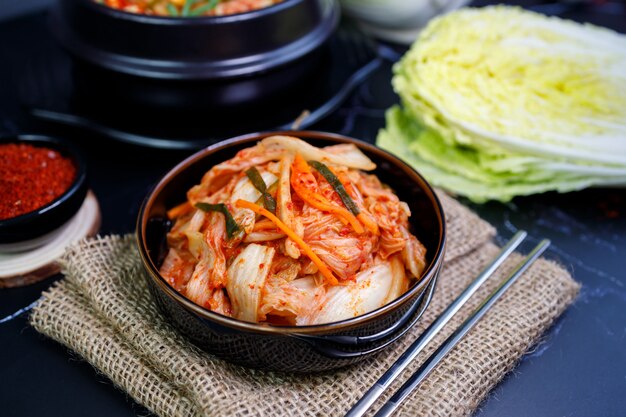Kimchi is a beloved Korean dish that brings a burst of flavor to any meal. Known for its tangy, spicy, and umami-rich taste, kimchi is a fermented vegetable dish, traditionally made with napa cabbage, radish, and a blend of spices. Making kimchi at home can be a fun and rewarding experience, and it allows you to customize the flavors to your liking. Here’s a simple guide to making your own kimchi.
Ingredients:
- 1 medium napa cabbage
- 1/4 cup sea salt
- 3 cups water (for soaking)
- 1 tablespoon grated ginger
- 5 garlic cloves, minced
- 1 tablespoon fish sauce (optional for extra umami)
- 2 tablespoons Korean red pepper flakes (gochugaru)
- 1 tablespoon sugar
- 3 green onions, chopped
- 1 medium daikon radish, julienned (optional)
Instructions:
- Prepare the Cabbage:
Start by cutting the napa cabbage into quarters and removing the core. Slice each quarter into smaller, bite-sized pieces. Place the cabbage in a large bowl, sprinkling each layer with sea salt. Once all the cabbage is salted, pour water over the cabbage to cover it. Let the cabbage soak for 2 hours, turning the cabbage halfway through. This process helps to soften the cabbage and draw out excess moisture. - Make the Kimchi Paste:
While the cabbage is soaking, prepare the kimchi paste. In a separate bowl, mix the garlic, ginger, fish sauce, sugar, and Korean red pepper flakes. Add a little water to achieve a thick paste-like consistency. The amount of red pepper flakes can be adjusted depending on how spicy you like your kimchi. - Rinse and Drain the Cabbage:
After the cabbage has soaked for 2 hours, drain it thoroughly. Gently rinse the cabbage to remove excess salt. You want the cabbage to be soft but not overly salty. - Mix the Ingredients:
In a large mixing bowl, combine the drained cabbage, chopped green onions, and julienned radish (if using). Add the kimchi paste and use your hands (wearing gloves to protect your skin from the chili) to thoroughly massage the paste into the cabbage and other vegetables. Make sure all the pieces are well-coated with the spicy, flavorful paste. - Pack the Kimchi into Jars:
Once your kimchi is well-mixed, pack it tightly into clean glass jars or an airtight container. Press the mixture down so that it’s tightly packed and there are no air pockets. Leave some space at the top of the jar as the kimchi will expand as it ferments. - Ferment:
Store the packed jars in a cool, dark place for 1-2 days at room temperature to allow the fermentation process to begin. Taste the kimchi after 1 day; if it has reached your desired level of tanginess, move it to the refrigerator to slow down the fermentation. Kimchi continues to ferment in the fridge, but at a slower pace, and it will last for several weeks.
Tips for Perfect Kimchi:
- Salt: The amount of salt you use during the soaking process is crucial for proper fermentation. Too much salt can make the kimchi too salty, while too little salt can result in improper fermentation.
- Fermentation Time: The longer you allow the kimchi to ferment, the more intense its flavor will become. You can experiment with the fermentation time to find your preferred level of sourness.
- Variations: Kimchi can be made with different vegetables such as cucumbers, carrots, or even leeks. Feel free to experiment with variations and find what you like best.
Enjoy Your Homemade Kimchi:
Kimchi can be enjoyed as a side dish, used as a topping for rice, or incorporated into various Korean dishes like kimchi jjigae (stew) or kimchi fried rice. With its bold flavors and probiotic benefits, making kimchi at home is not only a fun culinary project but also a great way to add a nutritious and delicious element to your meals.








